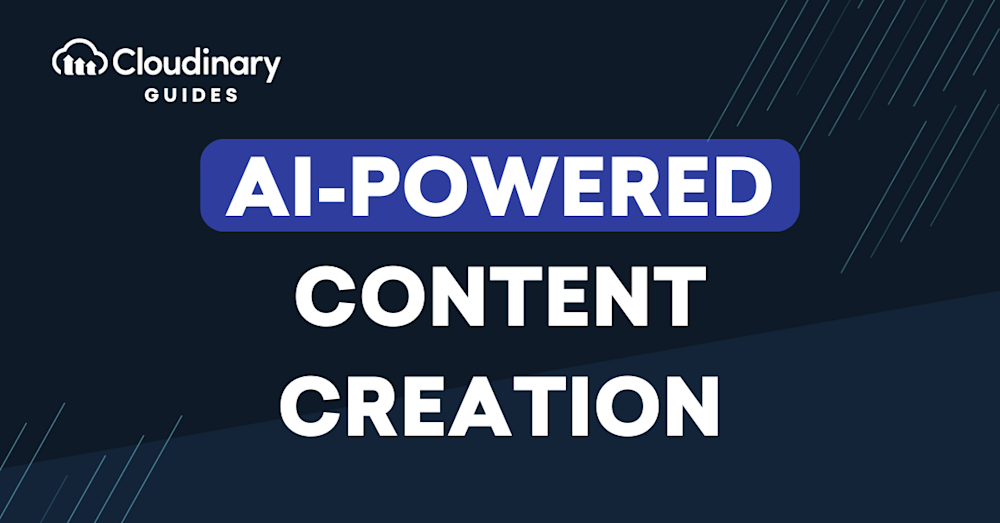Within the last twenty years (and the evolution of technology), the art of content creation has undergone a remarkable transformation. From traditional forms like print media to the dynamic world of digital content, creators have adapted to new mediums, technologies, and audience expectations. This evolution has paved the way for innovative methods and tools to shape the future of content production.
Enter AI-powered content creation, a groundbreaking paradigm shift that has the potential to redefine how we generate, curate, and deliver content. This introduction of artificial intelligence into content creation processes unlocks a world of transformative possibilities, promising efficiency, personalization, and scalability on unprecedented scales. In this article, we’ll cover everything you should learn about AI content generation today.
In this article:
- What is AI-Powered Content Creation?
- Who can benefit from AI-Powered Content Creation?
- Key Applications of AI in Content Creation
- Using Cloudinary for Content Creation
What is AI-Powered Content Creation?
AI-powered content creation encompasses a range of technologies and methods that employ artificial intelligence, machine learning, and data analysis to automate, improve, or aid in generating various types of content. It represents a synergy between human creativity and computational capabilities, resulting in relevant content tailored to the audience’s different preferences and needs.
This field encompasses numerous applications, from using natural language generation (NLG) for automating text creation to employing generative algorithms for generating images and videos. It relies on AI’s capacity to comprehend, process, and interpret data, rendering it a versatile and adaptable tool for content developers.
Specific AI tools such as Jasper.ai for blog post writing, Copy.ai for social media copywriting, and Canva for image generation exemplify this synergy, showing how AI can be tailored to different content creation needs. These tools, along with others like Surfer SEO for SEO writing, InVideo for video content creation, and Synthesia for avatar video creation, illustrate the wide range of applications that AI-powered content creation encompasses.
The use of AI in content strategy, where AI tools assist in creating content and planning and strategizing content production, marks an important evolution in the content creation landscape. This includes AI’s role in generating creative content like artwork, music, and virtual characters, showcasing its potential beyond traditional content types.
The Advantages of AI-Driven Content Creation
AI-driven content creation marks a transformative shift in content development, offering a range of substantial advantages for both content creators and businesses. The foremost benefit is the significant boost in efficiency it provides. By automating repetitive tasks like data analysis and initial content generation, AI frees up creative resources and allows creators to focus on more intricate and strategic aspects of content. This streamlining not only expedites the production process but also ensures consistent output.
The speed and efficiency of AI in producing large volumes of content quickly are particularly advantageous in today’s fast-paced digital environment. AI’s ability to swiftly generate blog posts, social media copy, ebooks, landing pages, emails, product listings, and audio/video content exemplifies this efficiency, catering to the diverse needs of the digital content landscape.
Another remarkable advantage is the unparalleled scalability of AI-driven content. It excels in tailoring content to diverse audiences and platforms, enabling businesses to expand their reach without compromising quality. Whether it’s crafting content variations for various social media platforms or delivering localized content to global audiences, AI seamlessly manages the demands of modern content distribution.
It also empowers personalized experiences that can foster better engagement through personalization. It helps curate content that resonates individually by analyzing user behavior, preferences, and historical interactions. This personalization builds stronger connections between users and content, leading to increased impact in the form of brand loyalty, higher conversion rates, and greater user satisfaction.
Who can benefit from AI-Powered Content Creation?
Artificial Intelligence (AI) has revolutionized many sectors, including content creation. From generating catchy headlines to crafting detailed articles, AI content creation tools have made the process more efficient and effective. These tools not only save time but also allow for greater creativity and versatility in content creation. Various sectors can significantly benefit from AI-Powered Content Creation.
Social Media Marketers
AI content creation tools are a game-changer for social media marketers, enabling the production of multiple variations of short-form copy, including headlines, quotes for graphics, and spotlight text. By turning a single piece of content into numerous social posts and suggesting ad copy, these tools streamline the content creation process. When combined with effective content curation and user-generated content strategies, it results in a wealth of high-quality social content with minimal human input.
E-commerce Businesses
E-commerce businesses stand to gain significantly from AI-powered content creation, particularly in enhancing online shopping experiences and engaging customers more effectively. AI can automate and personalize the creation of product descriptions, making them more appealing and relevant to different customer segments. Additionally, AI-driven chatbots can provide instant customer service, answering queries and offering recommendations, thereby improving user engagement.
Small Businesses and Startups
Small businesses and startups, often operating with constrained resources, can derive immense value from AI-powered content creation. This technology enables them to compete more effectively by automating the production of marketing materials, business documents, and customer communications. With AI, even businesses with limited budgets can create high-quality, engaging content that resonates with their target audience, from social media posts to personalized email campaigns.
Key Applications of AI in Content Creation
Artificial Intelligence isn’t just a subject of dazzling science fiction movies or the ominous predictions of the world’s leading tech minds. It’s right here, right now, transforming our interactions and real-world experiences in ways that were unthinkable just a decade ago, such as:
- Automated Writing Tools. AI-driven automated writing tools are changing the game when it comes to content generation. They can produce articles, blogs, and reports in a fraction of the time it would take a human writer. This efficiency speeds up content production and makes it more accessible. Content creators can now generate high-quality written material more quickly, allowing them to keep up with the demands of today’s fast-moving digital landscape.
- Visual Content. AI-driven graphic design tools have emerged as valuable assets for content creators. These tools empower creators to design, edit, and optimize images with ease. Whether it’s crafting visually stunning graphics for social media, websites, or marketing materials, AI-driven design tools enhance the overall visual appeal of content. This accessibility to professional-level graphic design capabilities is great for content creators who may not have extensive design skills, enabling them to create eye-catching visuals tailored for various platforms.
- Video Production. From video editing to animation and enhancement, AI-driven tools are streamlining various processes, simplifying these tasks, and making it more efficient to create captivating video content that engages the audience. This efficiency is particularly valuable in industries where video is a crucial medium, such as marketing, entertainment, and education. AI’s role in video production is democratizing the creation of high-quality videos, even for those without extensive technical expertise.
- Music Creation. AI’s influence extends beyond text and visuals into the realm of music and sound production. AI-powered tools can generate music tracks, create sound effects, and assist in audio editing. This transformation is revolutionizing how audio content is produced, making it more accessible to a broader range of creators. Musicians, podcasters, and content producers can benefit from AI’s ability to enhance the auditory experience, whether it’s by generating background music, adding effects, or automating editing processes.
- Media Transformation. AI’s impact on media is profound, encompassing various content creation and consumption aspects. From AI-driven video previews that recommend content to integrated Gen AI features that personalize user experiences, AI is fundamentally changing how we interact with media. This transformation opens exciting possibilities for content creators to tailor content to individual preferences and deliver more engaging and relevant experiences to their audiences.
Using Cloudinary for Content Creation
Cloudinary offers a powerful suite of robust AI-driven tools that can help empower your content creation process. Features such as generating video previews and performing AI tagging on images harness the capabilities of artificial intelligence to take your content to the next level.
Before diving into the practical examples we’ll discuss below, there are a few prerequisites you should have in place:
- Cloudinary Account – Since we’ll be using Cloudinary, you’ll need to have a Cloudinary account. If you don’t already have one, you can sign up here to get started.
- Node.js Installed – You’ll also need Node.js installed on your system to make use of Cloudinary’s capabilities.
- Basic JavaScript and Node.js Knowledge – Familiarity with basic JavaScript and Node.js will be beneficial as we continue.
Start by creating a Node.js project in the directory of your choosing and installing the Cloudinary Node JS SDK using the following node command:
npm install cloudinary
Next, login to your Cloudinary account, head over to the Dashboard tab and retrieve your Product Environment Credentials.
Now, create a .js file in your project directory and configure the Cloudinary SDK with your account credentials:
const cloudinary = require('cloudinary').v2;
cloudinary.config({
cloud_name: "your-cloud-name",
api_key: "your-api-key",
api_secret: "your-api-secret"
});
Replace your-cloud-name, your-api-key, and your-api-secret with your actual Cloudinary credentials.
Video Previews
Creating captivating video previews is essential to engage your audience effectively. With Cloudinary, you can easily generate these previews using AI-driven effects.
Let’s consider an example where you want to upload a video and create its preview. Start by creating an Assets folder in your project directory and adding a video file. Here, we will be using cld-sample-video.mp4, available in Cloudinary’s demo cloud.
Next, specify the path to the local video file you want to upload and set a custom public ID for the uploaded video:
const localVideoFilePath = './Assets/cld-sample-video.mp4'; const publicId = 'my-video';
Finally, use the uploader method to upload the video, then generate a preview using the effect parameter:
cloudinary.uploader.upload(localVideoFilePath, {
public_id: publicId,
resource_type: "video"
}, (error, result) => {
if (error) {
console.error(error);
} else {
// Generate a URL for the video with the "preview" effect
const videoPreviewUrl = cloudinary.video(publicId, {
effect: "preview",
resource_type: "video"
});
console.log("Video Preview URL:", videoPreviewUrl);
}
});
Here is what the preview looks like:
Generating Captions
After working with videos, let’s learn about content creation when working with images. AI content analysis for images involves extracting descriptive information from images, such as captioning an image. AI captioning and tagging is a game-changer when it comes to categorizing your images. Cloudinary’s AI capabilities make this process seamless. Here, we will be using boy-snow-hoodie.jpg, also available in Cloudinary’s demo cloud.
First, specify the path to the image you want to analyze and upload it to Cloudinary with the detection set to captioning:
const imageFilePath = './Assets/boy-snow-hoodie.jpg';
cloudinary.uploader.upload(imageFilePath, { detection: 'captioning' })
.then(result => {
console.log("AI Captioning Result:", result.info.detection.captioning);
})
.catch(error => {
console.error(error);
});
The result includes descriptive captions generated by the AI. By using AI tagging you can automatically analyze and tag images, making them more discoverable and organized.
Wrapping Up
The domain of AI-driven content creation has ushered in a transformative era. Its rapid content production, exceptional personalization, and scalability have revolutionized the content landscape. AI is no passing trend; it’s a cornerstone of the future. The future of content creation is intricately intertwined with AI, promising heightened efficiency, unprecedented creativity, and boundless innovation. It’s a journey worth undertaking, and those who do will thrive in the ever-evolving digital landscape.
If you’re ready to embark on this transformative journey and harness the full potential of AI in your content creation endeavors, you should sign up to Cloudinary. With Cloudinary’s AI features and tools, you can elevate your content to new heights, captivate your audience, and stay at the forefront of the ever-evolving digital landscape.
Learn more:
Mastering Content Marketing Assets






